Dentsu Inc.'s cross-functional creative organization, the Future Creative Center (FCC), is a group that supports the creation of the future through creativity, transcending the boundaries of advertising. This series introduces actual initiatives under the theme of "Future × Creativity."
One project has garnered immediate attention for its innovative approach of implementing Japanese master craftsmen's skills into AI. It has won numerous awards both domestically and internationally, including the Innovation category at the Clio Awards, one of the world's three major advertising awards.
Introducing TUNA SCOPE, a quality assessment AI that inherits the skills of tuna "eye-test" artisans.
This time, we spoke with Kazuhiro Shimura, the leader of the "TUNA SCOPE" project and Creative Director, about the development process behind the idea and future prospects.
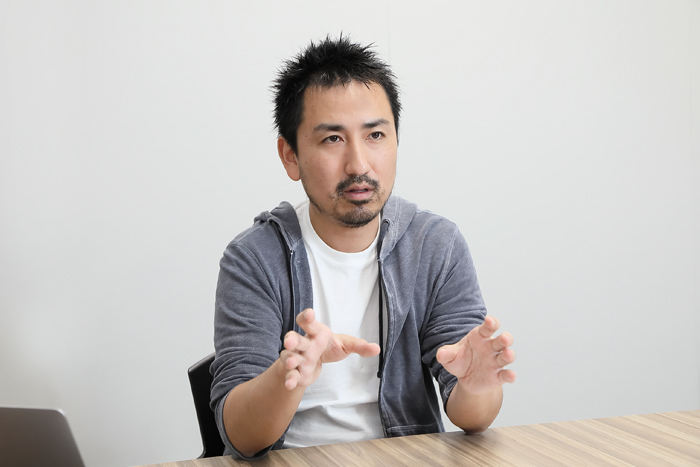
Kazuhiro Shimura (Creative Director, Dentsu Inc., Creative Planning Division 4)
An everyday observation sparked the project's inception
—What kind of technology is "TUNA SCOPE"?
Have you ever seen scenes on TV programs where market brokers examine the cut surface of a tuna's tail to assess something? These skilled craftsmen judge the tuna's quality by looking at the "cross-section of the tuna's tail." This technique relies on years of experience and the intuition built upon it—an extremely sensory "tacit knowledge" only a limited number of people can master.
TUNA SCOPE is the AI we developed that inherits this connoisseur's skill. By taking a photo of the tuna tail cross-section with a smartphone running TUNA SCOPE, anyone can easily assess the tuna's quality.
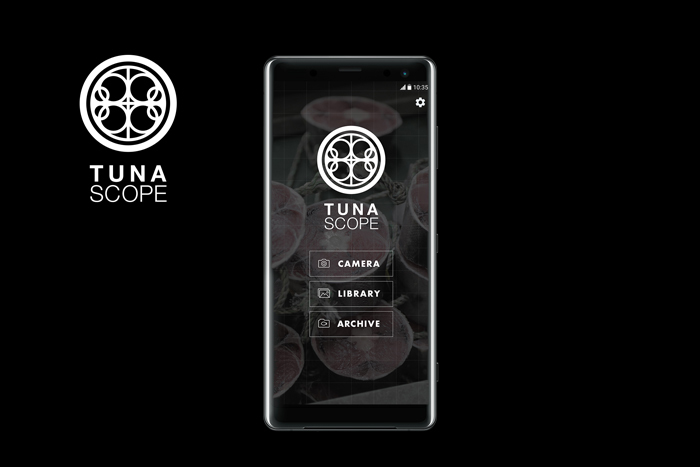
The TUNA SCOPE smartphone app we developed
—Please tell us how "TUNA SCOPE" came to be.
I've always loved fish and often buy tuna sashimi at the supermarket. Sometimes, though, I'd think, "This isn't as tasty as I expected." I wondered, "Why is there such variation in quality for tuna that looks similar and costs the same?" Around the same time, I saw news on TV about Tsukiji Market moving to Toyosu. Watching the wholesalers there inspecting tuna for quality sparked this idea.
At the market, tuna is priced based on the visual inspection of the "tail cross-section" by wholesalers with decades of experience. However, upon investigation, I learned these wholesalers face a shortage of successors, and the number of people possessing this valuable expertise is dwindling. That's when I had the flash of insight: could we entrust this wholesaler's skill to AI? AI could learn the craftsmen's intuition and complete the training—said to take at least 10 years—in no time. I thought that if this AI connoisseur could be widely applied to regular tuna, everyone could enjoy delicious tuna.
Furthermore, interviews with craftsmen revealed that this skill is "tacit knowledge" – highly intuitive. If we could verbalize what they look for, we could create manuals for trainees or program it into software. But this connoisseurship is an intuitive skill that defies easy verbalization. This made it all the more intriguing. I believed training AI held significance for preserving this invaluable skill, cultivated over decades of daily observation of tuna tails.
Could we digitize the skills of these limited artisans, make them widely accessible, and introduce that value to the tuna we eat in our daily lives? After presenting this vision and my passion within Dentsu Inc., the project was officially launched. We formed a team combining Dentsu Inc.'s creative expertise with ISID's technological strength.
In just one month, the AI learned tuna evaluation skills equivalent to over 10 years of artisan experience.
—What was particularly challenging during development?
Collecting cross-sectional images of tuna tails. To train the AI with the equivalent of 20 to 30 years of artisan expertise, we needed a massive amount of sample data. However, the fish markets where these artisans assess tuna daily are not easily accessible to non-artisans. So, we shifted our thinking: where could we find a source with extensive tuna data? That's when we connected with Sojitz, a global trading company operating in the tuna business.
Using data collected from tuna at Misaki Port, we created an application prototype and took it to them for consultation. When we explained the project outline, we discovered that Sojitz also faced business challenges, such as individual variations in the accuracy of connoisseurs and the hit-or-miss nature of purchasing. With "TUNA SCOPE," high-quality tuna meeting consistent standards can be reliably supplied regardless of who performs the inspection. Our shared vision aligned, leading to their participation in the project.
With Sojitz's cooperation, we gathered sample data from over 4,000 yellowfin tuna. We meticulously photographed the cross-sections of these samples using smartphone cameras, cross-referenced them with the craftsmen's evaluations, and fed these sets into the AI. In just one month, we succeeded in training the AI with a volume equivalent to over ten years of apprenticeship for a craftsman inspecting one tuna per day.
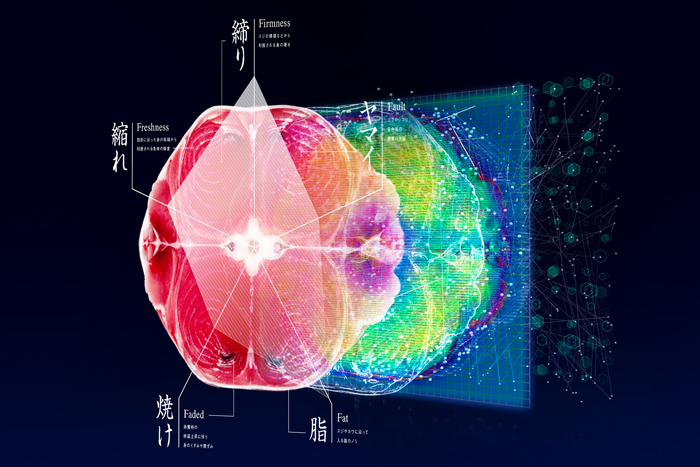
An AI mastered the discerning eye of a lifetime in just one month
After implementing and testing the developed AI on smartphones, it achieved an accuracy rate of approximately 85% when compared to the judgments of a 35-year veteran artisan. Recently, it has reached a point where it correctly identifies tuna deemed high-quality by skilled artisans as "delicious" with a probability exceeding 90%.

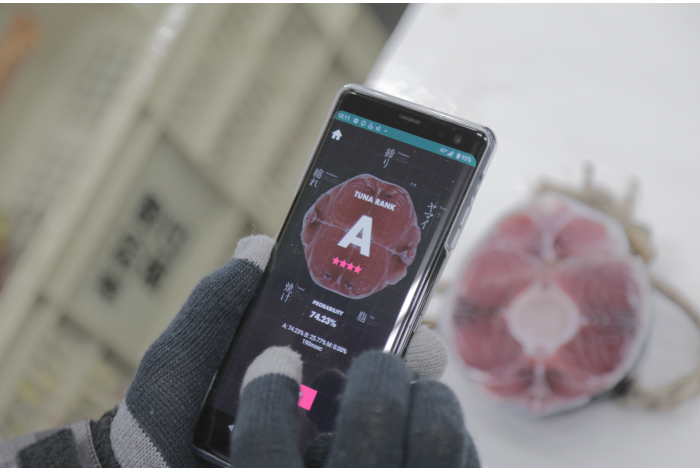
At the Yaizu factory, comparing the AI's results with those of craftsmen recorded a high rate of agreement
—I hear you sold tuna rated as the highest quality by "TUNA SCOPE" as "AI Tuna" and conducted field surveys.
In March 2019, at "Sanchoku Gourmet Kaiten Sushi Kantaro Tokyo" in Tokyo Station, we added tuna rated highest by TUNA SCOPE to the regular menu as "AI Tuna" (¥280, tax excluded) and sold it. We sold out approximately 1,000 plates over 5 days. Survey results showed about 90% of customers rated it tastier than tuna in the same price range. Customer feedback like "It's actually tastier than the usual tuna" and "If this AI is implemented, I'm really happy and feel reassured that I can enjoy delicious tuna as expected" was particularly memorable.
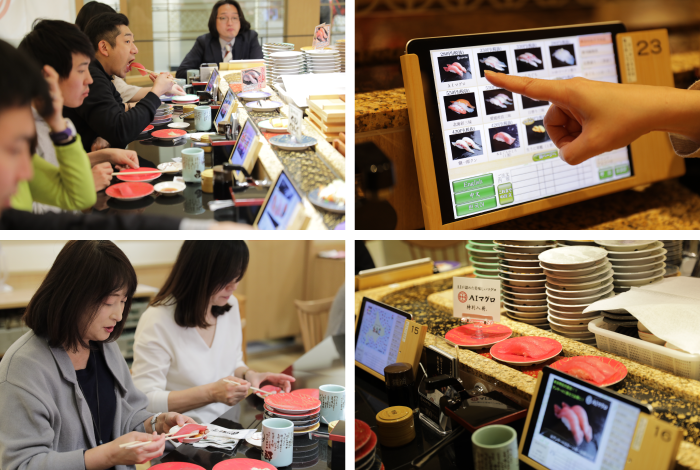
Successful Sales of "AI Tuna"
2020: TUNA SCOPE Tuna Expands Globally
—Please tell us about the project's future outlook.
As a concrete future development, starting in January, TUNA SCOPE AI-quality-assessed tuna began being offered in New York and Singapore.
Furthermore, in March, the project was certified under the Fisheries Agency's "Collaborative Promotion Project for Expanding Seafood Exports." In 2020, with support from the Fisheries Agency, we are preparing to export high-quality tuna, assessed by AI, worldwide.
I believe TUNA SCOPE's global expansion holds significant value in multiple ways. First, it means anyone, anywhere in the world, can enjoy delicious tuna. The world lacks professional connoisseurs like Japanese artisans who have spent their entire lives observing tuna. Consequently, tuna currently reaches people's tables without undergoing the same high-level quality assessment as in Japan. However, by extending the capabilities of Japanese artisans globally through AI, people worldwide will be able to enjoy delicious tuna selected with Japanese discernment. This is something we Japanese are also delighted about.
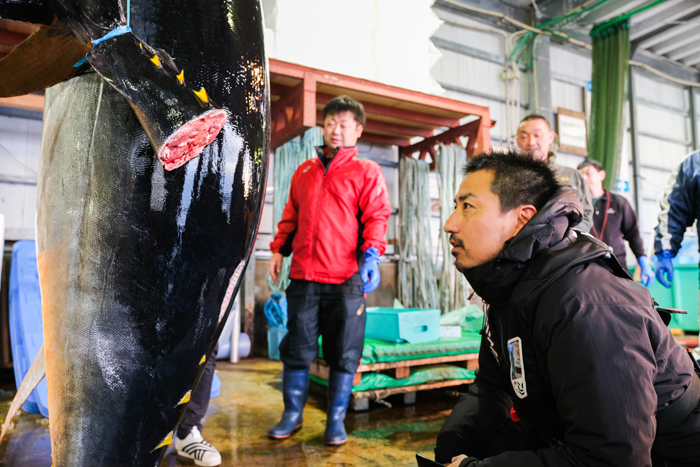
Through TUNA SCOPE, we plan to expand Japanese expertise globally
Another reason is that we believe "TUNA SCOPE" could also help solve the global challenge of "tuna resource issues."
The ordinary tuna we consume daily is primarily traded by weight or volume. Consequently, in problematic overfishing practices, the focus is on "quantity," leading to mass capture of entire schools—including juveniles—to catch large numbers. Furthermore, fish caught en masse thrash violently in nets, causing their body temperature to rise and spoil the flesh, inflicting injuries, or even killing them. This results in a significant loss of freshness.
By introducing "TUNA SCOPE" and establishing a globally unified quality standard with a certification system, we believe we can shift the focus of fishermen towards "quality." More fishermen will likely choose to catch tuna carefully, one fish at a time, prioritizing quality and freshness over mass capture. Tuna from fishing vessels that catch carefully will be valued in the market, allowing everyone to enjoy delicious tuna while also stabilizing the resource. This could create a win-win relationship for people, resources, and business.
The TUNA SCOPE project began as an individual's vision, but it has expanded and is now evolving into a venture with the potential to solve societal challenges. Moving forward, we aim to leverage the expertise gained from this project to expand activities that preserve master craftsmen's skills through AI, extending beyond the fisheries industry into various other fields.
TUNA SCOPE: https://tuna-scope.com/jp/
Release: https://www.dentsu.co.jp/news/release/2020/0424-010044.html











